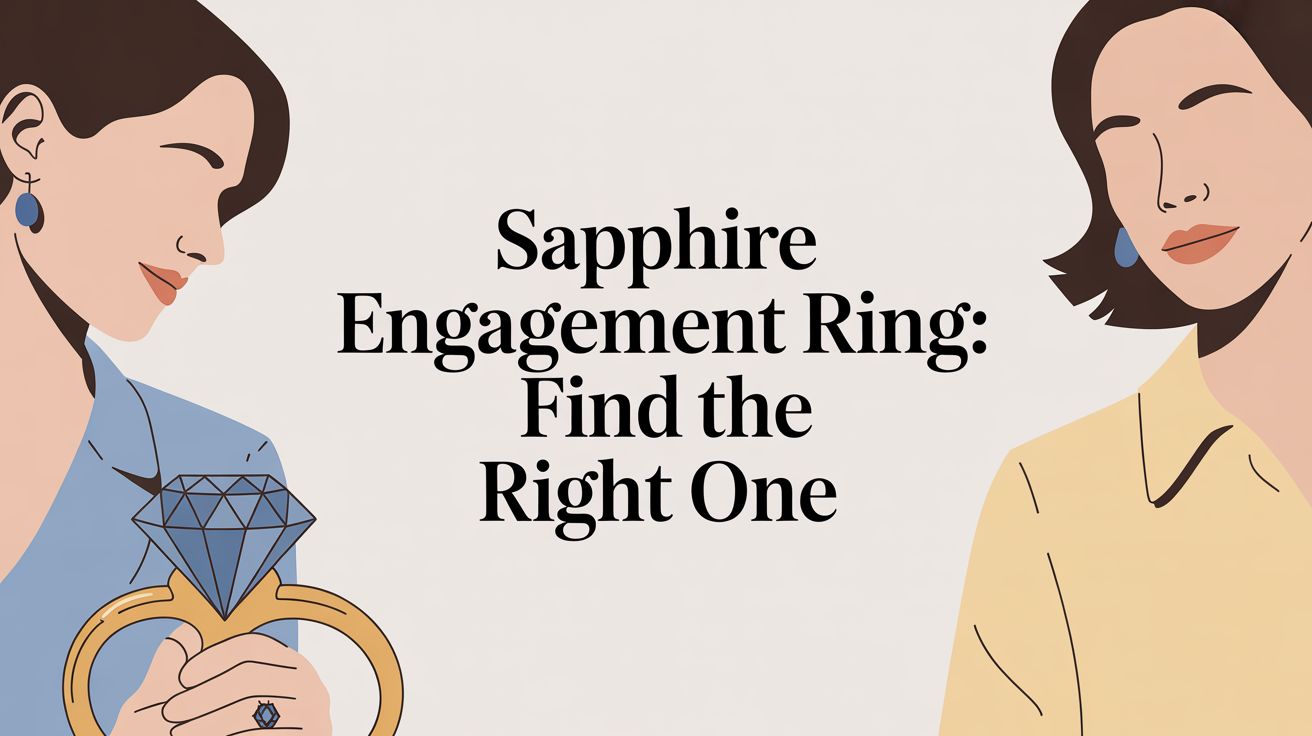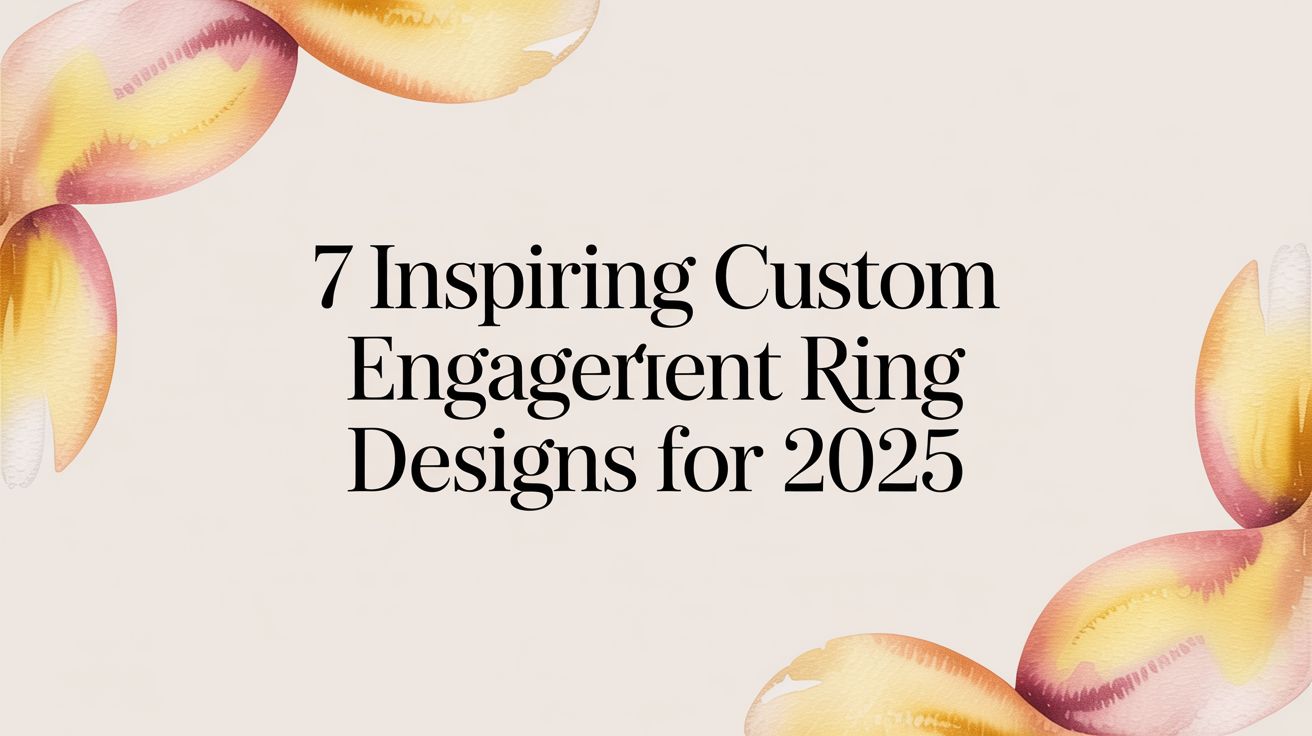Choosing a sapphire engagement ring is more than just a style choice; it’s a decision to embrace something with unmatched durability and a rich, timeless history. It's a deeply personal statement for couples who want a vibrant alternative to the traditional diamond, something that truly stands for their unique partnership.
Why Choose a Sapphire Engagement Ring
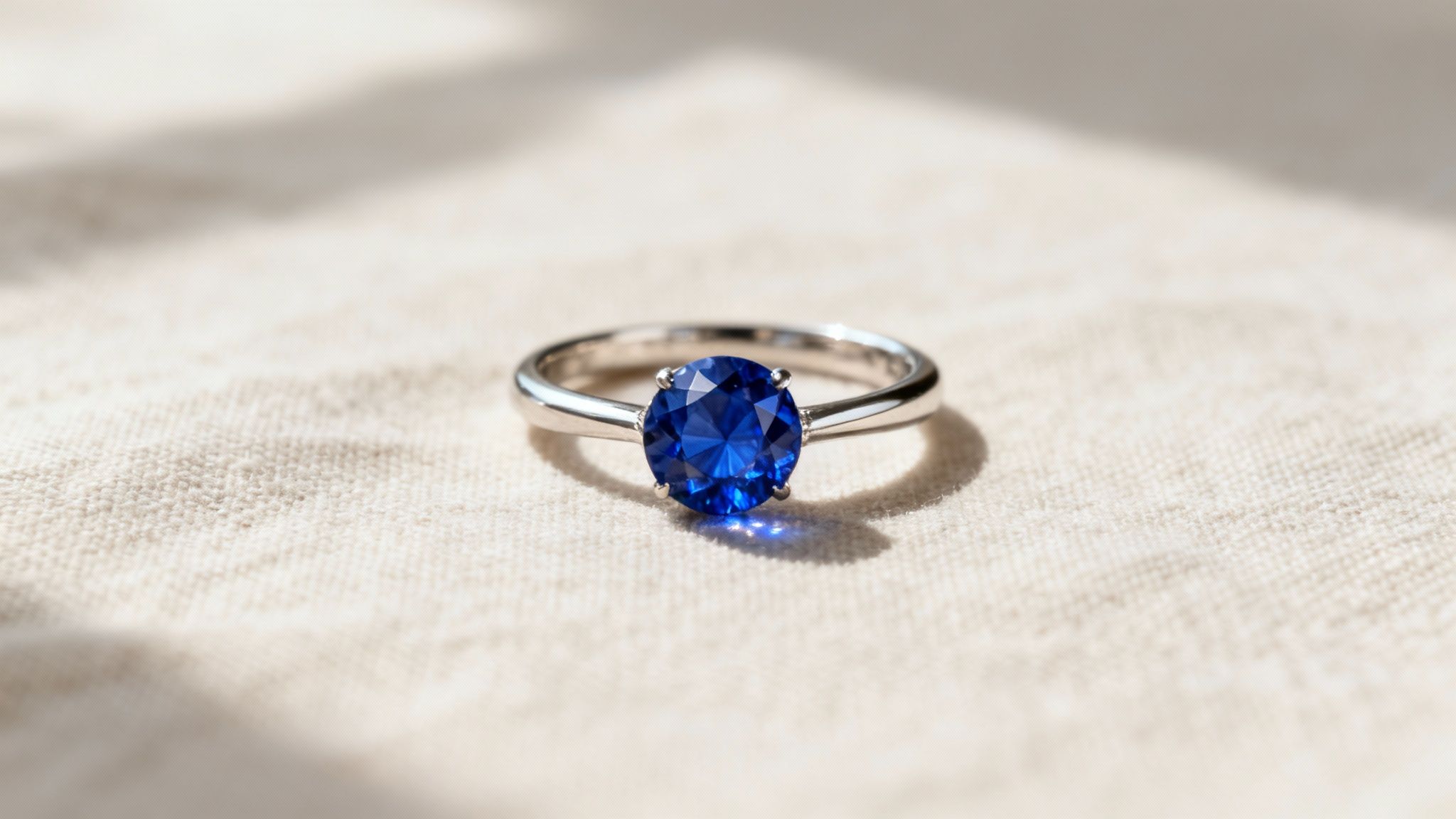
Stepping away from the classic diamond is a move towards personal expression, a desire for a ring that feels truly one-of-a-kind. A sapphire engagement ring isn't just following a trend; it's a statement of individuality and enduring love, blending practical strength with profound meaning.
A Symbol of Loyalty and Wisdom
Sapphires have been treasured for centuries, steeped in symbolism. Historically, these mesmerising blue gems were seen as signs of wisdom, faithfulness, and nobility. When you choose a sapphire, you're embracing a legacy of integrity and sincerity for your relationship.
Each stone carries its own story, making it far more than just a piece of jewellery. It becomes a personal talisman, reflecting the qualities you value most in your partner. This depth of meaning is something that resonates deeply with many couples starting their lives together.
Unmatched Durability for Everyday Life
Let's talk practicality. A ring you wear for a lifetime needs to be tough. Sapphires are exceptionally hard, scoring a 9 on the Mohs scale of hardness—just a single step behind diamonds at a perfect 10. This inherent toughness makes them incredibly resistant to the scratches and knocks of daily life.
A sapphire engagement ring is an ideal choice for anyone with an active lifestyle. Its resilience ensures the stone will maintain its brilliance for decades with the right care, giving you peace of mind alongside its stunning looks.
This durability means your ring is built to last, perfectly mirroring a strong and enduring commitment.
Royal Connections and Timeless Appeal
The link between sapphires and royalty has cemented their status as a sophisticated, elegant choice. The association was famously sealed with the iconic engagement ring given to Princess Diana, now worn by Catherine, Princess of Wales. Here in the UK, that royal endorsement has given their popularity a huge boost.
In fact, the UK market has seen engagement ring sales jump by 28.8% between 2022 and 2024, partly driven by the growing love for these beautiful gems. This blend of royal history and modern appeal makes a sapphire engagement ring a timeless investment.
Choosing a sapphire lets you create something that is uniquely yours, breaking from convention while still honouring a tradition of elegance and strength. Whether you're drawn to the vibrant colour or its meaningful history, a sapphire offers endless possibilities. If you're looking to create a true one-off piece, exploring custom engagement ring designs can help bring your vision to life.
Evaluating Sapphire Quality Like an Expert
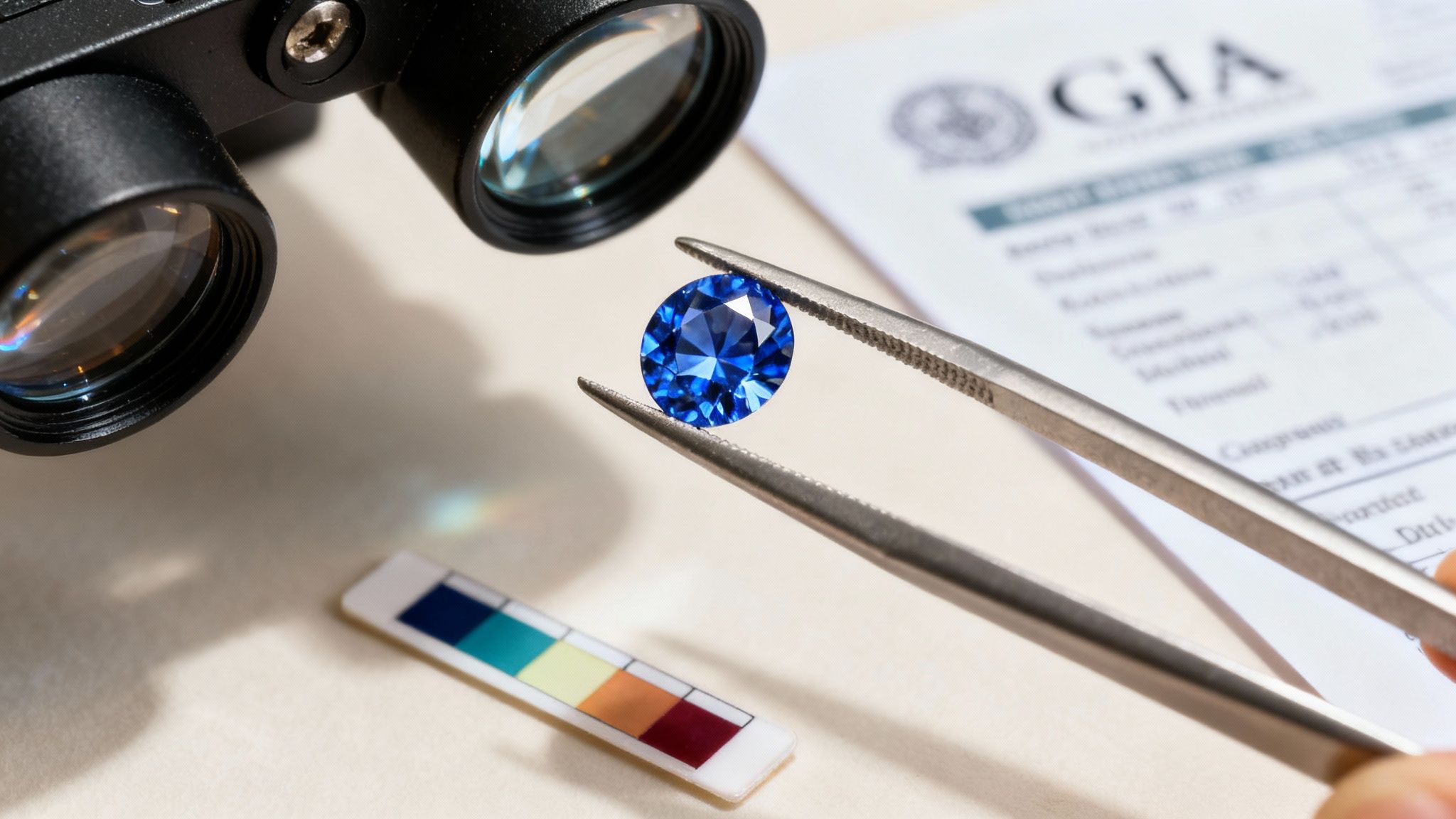
Choosing a sapphire involves appreciating subtleties that go far beyond a quick glance. While diamonds are famously judged by the ‘Four Cs’—cut, colour, clarity, and carat—sapphires play by slightly different rules. With sapphires, colour is king, but the story definitely doesn't end there.
Getting to grips with these quality factors is what separates a pretty stone from a truly exceptional one that's a worthy investment. I'll walk you through how we, as professionals, assess sapphire quality, so you can feel confident you’re choosing the best. You'll learn what gives a sapphire its soul and how to spot a real treasure.
Deconstructing Sapphire Colour
Colour is hands down the most critical factor in a sapphire's value, often accounting for most of its price tag. Unlike diamonds, where you're looking for an absence of colour, sapphires are celebrated for their rich, intense hues. To really understand it, we break it down into three parts.
Hue: This is the stone's primary colour. While everyone thinks of blue, sapphires come in a whole rainbow of "fancy" colours like pink, yellow, and green. For a classic blue sapphire, the goal is a pure, vivid blue with minimal purple or green undertones peeking through.
Tone: This is all about the lightness or darkness of the colour. The sweet spot is a medium to medium-dark tone. A stone that’s too light can look a bit washed out, but one that's too dark can appear inky or black in lower light, losing all its life.
Saturation: This refers to the purity or intensity of the colour. A sapphire with strong, vibrant saturation looks brilliant and alive. Weak saturation makes a stone look greyish or dull. The most sought-after sapphires have that rich, velvety saturation that’s even across the entire stone.
The legendary "cornflower blue" and "royal blue" sapphires are so prized because they nail this trifecta: a pure blue hue, a medium-dark tone, and knockout saturation.
A quick way to remember what to look for is to think about the three key aspects of sapphire colour.
Sapphire Colour Grade Quick Reference
| Quality Factor | What to Look For | What to Avoid |
|---|---|---|
| Hue | A pure, primary colour (e.g., pure blue). | Obvious secondary colours (strong green or violet undertones). |
| Tone | Medium to medium-dark. Rich but not blackish. | Too light (washed-out) or too dark (inky). |
| Saturation | Strong, vivid, and evenly distributed. | Weak, greyish, or patchy colour. |
Ultimately, the perfect combination of these elements creates that breathtaking colour that makes sapphires so special.
Understanding Clarity and Inclusions
Clarity in a sapphire isn't judged in the same way as a diamond. Diamonds are expected to be flawless under a loupe, but sapphires are a Type II gemstone, which means they almost always have some natural inclusions. Think of these tiny internal features as the gem's fingerprint—a unique part of its story and proof of its natural origin.
Inclusions aren't necessarily a bad thing. In fact, a total lack of them can be a red flag for a synthetic stone or even glass. Some microscopic needle-like inclusions, known as "silk," can actually soften the light passing through the stone, giving it a beautiful, velvety glow.
The real test is whether the stone is "eye-clean," meaning you can't see any distracting inclusions with the naked eye from a normal distance. What you want to avoid are large, dark crystals or internal fractures that threaten the stone's durability or spoil its beauty.
When you're looking at a ring, view the sapphire from different angles and under different lights. This will show you if any inclusions are prominent enough to interrupt the flow of colour and sparkle.
The Importance of an Excellent Cut
The cut is what unlocks a sapphire's potential. It's the human touch that breathes life into the stone, and a great cut will maximise its colour and hide any minor inclusions. Unlike diamonds, there isn't a strict, universal grading system for sapphire cuts, which means it all comes down to the cutter's skill.
A master gem cutter has several goals in mind when shaping the rough crystal:
- Maximise Colour: The facets are angled to deepen the stone's hue, tone, and saturation, making sure the colour looks rich and even when you look down into it.
- Enhance Brilliance: A well-proportioned cut allows light to bounce around inside the stone and shoot back out as sparkle. A poorly cut stone often has a "window"—a dull, see-through patch in the middle where light just leaks out the back.
- Preserve Carat Weight: The cutter also tries to keep as much of the original stone's weight as possible, carefully balancing size against beauty.
This means a slightly smaller but expertly cut sapphire will always be more stunning (and valuable) than a larger, poorly cut one. Don't get hung up on carat weight alone; always, always prioritise a cut that makes the gemstone sing.
The Fifth C: Country of Origin
With sapphires, its birthplace adds a unique layer of romance, rarity, and value. While gemmologists can pinpoint a stone's origin by studying its specific inclusions and chemistry, this "fifth C" has a huge impact on its desirability and price.
Historically, the most revered sapphires have come from just a few legendary sources.
- Kashmir: These are the holy grail of sapphires. Mined for only a short time in the late 19th century, they're famous for their velvety, cornflower blue glow, caused by fine silk inclusions. A certified Kashmir sapphire is a true collector's piece and incredibly rare.
- Burma (Myanmar): Burmese sapphires are known for their deep, intense "royal blue" colour and fantastic clarity. They are highly coveted and fetch premium prices.
- Ceylon (Sri Lanka): Sri Lanka is a major source of beautiful sapphires today. Ceylon stones are often a bit lighter, ranging from a pale sky blue to that prized vibrant "cornflower" hue.
While origin adds to the story, remember that a beautiful stone is a beautiful stone, no matter where it was mined. That said, a certificate from a reputable lab like the GIA confirming a prestigious origin like Kashmir can dramatically increase the value of your ring. It's a piece of history you can wear.
Right, you've got a handle on sapphire quality. Now for the fun part: choosing its shape and cut. These two things are what give a sapphire its personality, turning it from a gorgeous stone into the star of the show on your finger.
The shape is the stone's outline—think oval, round, or emerald. The cut, on the other hand, is all about the tiny facets that make it sparkle. One isn't more important than the other; they work together to define how the ring looks and feels.
A brilliant-style cut, for example, is engineered to maximise sparkle. A step-cut, like an emerald, is designed to show off a sapphire's incredible depth of colour and clarity. Your choice here really sets the tone for the entire ring, whether you're aiming for classic and romantic or something a bit more modern and bold.
Classic Shapes for Timeless Brilliance
Some shapes just never go out of style, and for good reason. They're versatile, flattering, and brilliant, making them a stunning—and safe—bet for a sapphire engagement ring.
Round Brilliant Cut: This is the undisputed champion of sparkle. With 58 facets angled with mathematical precision, it's designed to catch and reflect as much light as possible. It’s a classic choice that lets the sapphire’s quality do all the talking and looks just as good in a simple solitaire as it does in a flashy halo setting.
Oval Cut: An oval gives you all the fire of a round brilliant but with a contemporary, elongated twist. This shape is a favourite because it’s so flattering; its length can make the finger appear longer and slimmer. Ovals also tend to look larger for their carat weight compared to a round stone, which is a nice bonus.
These two are absolute mainstays in the jewellery world. You simply can't go wrong if you're after that timeless sparkle everyone loves in an engagement ring.
Modern Cuts for a Unique Statement
If "classic" isn't quite your style, there are plenty of modern cuts that let you express a bit more personality. These shapes often have a vintage or even an Art Deco vibe, focusing less on pure glitter and more on highlighting the sapphire's luxurious colour.
Take the emerald cut. It uses long, rectangular 'step' facets that create a mesmerizing "hall-of-mirrors" effect. It doesn't sparkle in the traditional sense; instead, it offers dramatic flashes of light and gives you a deep, clear window right into the heart of the stone. It's a confident, sophisticated choice for someone who appreciates clean lines and understated glamour.
Then there's the cushion cut, with its soft, rounded corners and romantic, vintage charm. It’s a beautiful hybrid, blending the brilliance of a round cut with a unique pillow shape for a gentle sparkle that feels both personal and timeless.
Remember, the perfect shape is the one that feels right for the person wearing it. Look at their other jewellery. Are they drawn to classic elegance or something more contemporary? That's usually your best clue.
It's no surprise that sapphires are a top choice for UK engagement rings. Their sheer variety in shapes and colours allows for so much personalisation. While the classic appeal of rounds and ovals is here to stay, we're seeing more and more couples lean towards emerald and cushion cuts for a stylish, modern alternative. This is all part of a bigger trend, with marriages and engagement ring sales on the rise post-pandemic. To see where things are headed, you can check out the latest insights on 2025 sapphire trends from Hancocks Jewellers.
Matching Shape to Hand and Setting
The final piece of the puzzle is making sure everything works together visually. The sapphire’s shape should not only suit the wearer's style but also flatter their hand and pair beautifully with the ring's setting.
For instance, elongated shapes like ovals, marquise, and pear cuts create an illusion of length, which can be a fantastic choice for shorter fingers. In contrast, round or squarer shapes, like the cushion or princess cut, tend to look lovely on longer fingers.
The setting itself plays a massive role. A simple four-prong solitaire puts all the focus on the sapphire, making its shape the absolute star. A halo setting, which surrounds the centre stone with a ring of tiny diamonds, can make the sapphire look larger while adding another layer of sparkle.
Ultimately, it helps to visualise the finished ring. Thinking about how the stone, the setting, and the hand all come together will guide you to a choice that's cohesive, stunning, and deeply personal.
How to Choose the Perfect Ring Setting
Once you’ve found the perfect sapphire, the setting is what transforms it from a beautiful gemstone into a breathtaking piece of jewellery. It's the frame that holds your masterpiece, defining its character and making sure it’s secure enough for a lifetime of wear. The right mix of setting style and metal will not only protect your sapphire but amplify its natural beauty.
Think of the setting as the supporting actor—it should enhance the star of the show, not overshadow it. From a simple solitaire that screams classic elegance to an intricate halo that adds a layer of modern glamour, your choice sets the entire tone. This is where your personal style and day-to-day life really come into play.
Deciding on the perfect cut for your sapphire is a key first step that influences your setting choice. This decision tree can help you visualise which direction to go based on what you value most in a stone, whether it's sparkle, colour, or a vintage aesthetic.
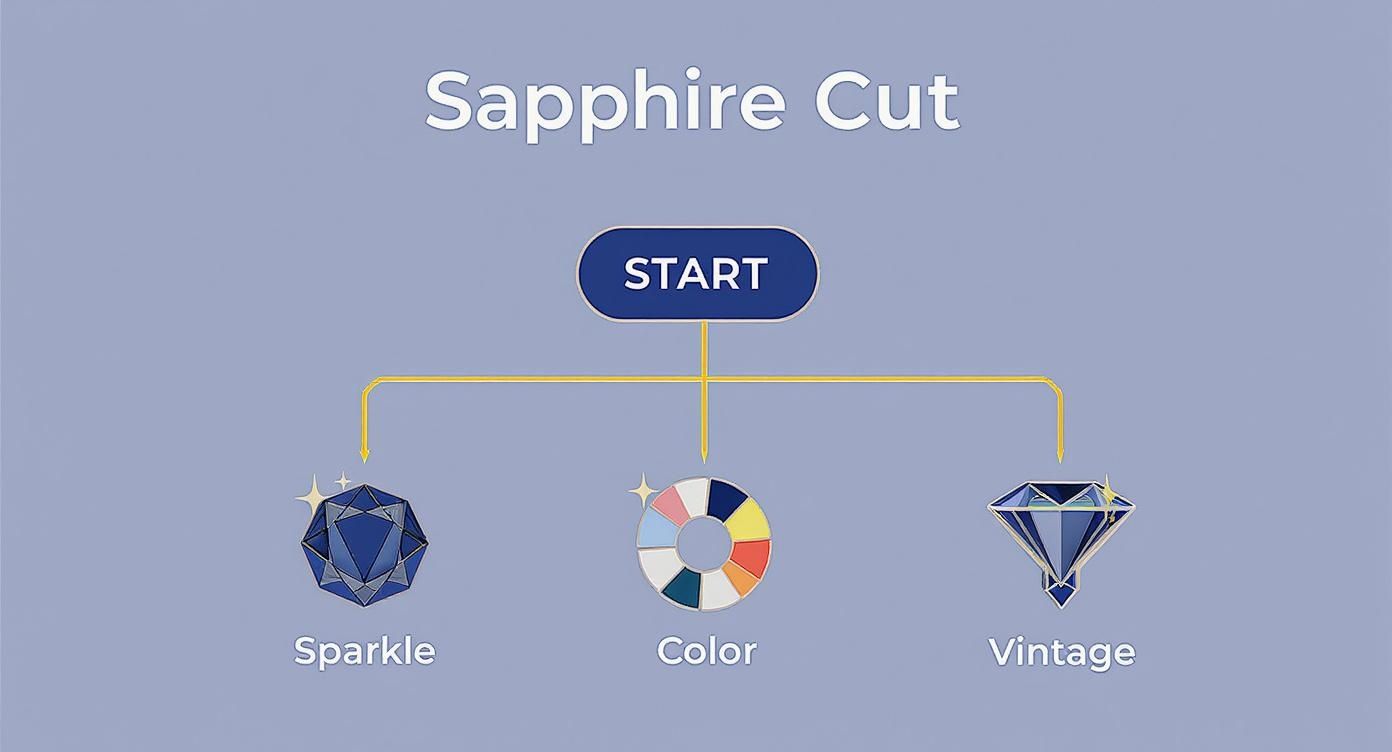
As the infographic shows, your priorities—be it dazzling brilliance, rich colour depth, or an antique feel—lead you to different cut families, which in turn pair best with specific settings.
Popular Setting Styles for Sapphires
The setting style you choose is a direct reflection of your personality. A classic solitaire places all the emphasis on the sapphire, making a confident statement about its quality and colour. It’s a timeless choice that never goes out of fashion.
For those who want a bit more sparkle, a halo setting is a fantastic option. By encircling the centre stone with a ring of smaller diamonds, a halo creates a dazzling frame that can make the sapphire appear significantly larger. It's a style that brings instant glamour and luxury.
Another meaningful choice is the three-stone ring. Flanking the central sapphire with two smaller diamonds or other gemstones, this setting is rich with symbolism, often representing a couple's past, present, and future. It’s a beautiful way to tell a story through your ring's design.
Consider the visual balance. A large, bold sapphire might be perfectly showcased in a simple solitaire, while a more delicate stone could be wonderfully enhanced by the added presence of a halo or side stones.
Choosing the Right Metal Colour
The metal you choose has a dramatic impact on the final look of your sapphire engagement ring. It's not just about durability; it's about how the metal’s colour interacts with the deep hue of the gemstone.
Cool-toned metals are a popular choice for blue sapphires because they create a striking contrast that makes the blue appear even more vibrant and intense.
- Platinum: The premium choice, platinum is naturally white, incredibly durable, and hypoallergenic. Its bright, silvery hue provides a crisp backdrop that really makes a blue sapphire pop.
- White Gold: A more affordable alternative to platinum, white gold achieves its silvery appearance through an alloy of yellow gold and white metals. It’s usually plated with rhodium for a brilliant finish. To keep its bright white shine, it will need replating every few years. You can learn more about how long rhodium plating lasts to understand the maintenance involved.
Warm-toned metals, on the other hand, offer a more classic or vintage feel.
- Yellow Gold: The timeless warmth of yellow gold creates a beautiful, rich contrast with a blue sapphire. This combination has a traditional, almost royal feel that has been cherished for centuries.
- Rose Gold: For a modern, romantic twist, rose gold’s soft pinkish hue provides a unique and stylish alternative. It pairs beautifully with sapphires of all colours, adding a touch of warmth and individuality.
Matching the Setting to Your Lifestyle
Finally, practicality is key. Your engagement ring should be beautiful, but it also needs to stand up to your daily activities. The security of the setting is a crucial consideration.
A traditional prong setting is popular because it uses minimal metal, allowing maximum light to enter the sapphire and create sparkle. The trade-off? The prongs can occasionally snag on clothing and may need tightening over time to keep the stone secure.
For someone with a very active lifestyle or a hands-on job, a bezel setting might be a better choice. This style encases the entire edge of the sapphire in a thin metal rim, offering the ultimate protection against knocks and bumps. While it provides unparalleled security, it does cover more of the stone, which can slightly reduce its brilliance.
Your lifestyle should guide this decision. By balancing aesthetics with practical needs, you can choose a setting that is not only stunning but also perfectly suited to you, ensuring your sapphire engagement ring remains a cherished symbol for years to come.
Caring for Your Sapphire Engagement Ring
A sapphire engagement ring is a symbol of enduring love. With the right care, its deep blue brilliance can genuinely last a lifetime—and beyond.Sapphires are incredibly durable, second only to diamonds, but that doesn't mean they're immune to the realities of daily life. The key to keeping your ring as stunning as the day you first saw it is to build a few simple habits into your routine. This isn't about complicated rituals or expensive products, just a bit of common sense and gentle care.
Gentle At-Home Cleaning
Keeping your sapphire sparkling is surprisingly straightforward. All you really need is a simple solution of warm water mixed with a few drops of mild dishwashing liquid. It's best to steer clear of harsh chemicals like bleach or ammonia, which can damage the metal of the setting over time.
To get it clean:
- Soak the ring in the soapy water for about 20-30 minutes. This gives it time to break down any oils, lotions, and general grime that's built up.
- Next, take a very soft-bristled toothbrush (a baby toothbrush is perfect for this) and gently scrub around the setting and behind the stone where dirt loves to hide.
- Rinse it completely under warm running water to wash away all the soap residue.
- Finally, pat it dry with a soft, lint-free cloth.
For a more thorough clean without visiting a jeweller, it's crucial to use the right techniques. We've put together a full guide on how to clean your rings safely at home, so you can restore that showroom sparkle with complete confidence.
Smart Daily Habits to Protect Your Ring
Often, the best way to care for your ring is knowing when not to wear it. While sapphires are tough, they aren’t indestructible. A few small adjustments to your daily routine can make a huge difference in preventing accidental damage.
It's always a good idea to take your ring off before:
- Exercising or playing sports: A hard knock could potentially chip the sapphire or, more likely, bend the prongs holding it in place.
- Gardening or heavy cleaning: Dirt and abrasive chemicals can easily scratch the metal band and dull the stone's surface.
- Swimming: Chlorine is quite harsh on precious metals, and the cold water can cause your fingers to shrink, making it dangerously easy for a ring to slip off.
- Applying lotions or cosmetics: These products build up a film on the stone, which is the number one culprit for a dull, lifeless-looking sapphire.
The Importance of an Annual Professional Check-Up
Think of a professional jeweller as your ring’s doctor—an annual check-up is essential for its long-term health and security. We can give it a deep clean in an ultrasonic bath, which safely lifts away stubborn grime from every last crevice in a way you simply can't at home.
Even more importantly, we'll inspect the entire setting under magnification. This allows us to check that the prongs are still tight and your precious sapphire is secure. This single piece of preventative maintenance is the best way to avoid the heartbreak of losing a stone.
With the UK jewellery market projected to hit over USD 9.7 billion by 2035, there's a growing appreciation for beautifully crafted pieces. Proper, professional care ensures your own ring remains a treasured part of that legacy. You can read more about the UK jewellery market's growth on Spherical Insights.
Common Questions About Sapphire Rings
When you’re looking at a sapphire for an engagement ring, questions are a good thing. It’s a huge decision, both for your wallet and your heart, and getting the facts straight means you’ll end up with a piece you truly love.
We get asked these all the time in the workshop. From durability debates to colour myths, here are the straightforward answers to help you feel confident in your choice.
How Does a Sapphire Compare to a Diamond?
It’s less about which is “better” and more about which feels like you.
The most practical difference is hardness. Sapphires land at a 9 on the Mohs scale, just a whisper behind diamonds at a perfect 10. That means they’re incredibly tough and more than ready for the everyday wear an engagement ring goes through. You don't have to worry about them.
From a budget point of view, sapphires usually give you a bigger presence for your money. A one-carat sapphire is often more accessible than a one-carat diamond of similar quality, which can let you go for a more striking centre stone. But really, the biggest difference is colour. A sapphire offers a rich, deep alternative to a classic diamond, with a royal history to back it up.
Are All Sapphires Blue?
Definitely not—and this is one of their best-kept secrets! While blue is the icon, sapphires come from the corundum mineral family, which produces an incredible rainbow of colours. You can find absolutely stunning sapphires in pink, yellow, green, and even purple. In the trade, we call these "fancy sapphires."
The only colour corundum doesn't do is red. A red corundum gem gets its own legendary name: ruby. This variety opens up a whole world of personalisation, letting you pick a colour that reflects your style or holds a special meaning.
"From royalty like Princess Diana to the Titanic’s Heart of the Ocean, sapphires are a long beloved gemstone. Their deep blue hues are highlighted best in white gold and platinum... Symbolizing wisdom and faithfulness, September’s birthstone is also renowned for its durability."
What's the Difference Between Natural and Lab-Grown Sapphires?
Think of it like ice from a glacier versus ice from your freezer. They are chemically, physically, and optically identical. Even a trained jeweller can't tell them apart just by looking. The difference is all in the origin, rarity, and the story they carry.
- Natural Sapphires: Mined from the earth, these have formed over millions of years. Their natural origin gives them a sense of history and rarity, which is a big part of their appeal and value.
- Lab-Grown Sapphires: Created in a lab that mimics the earth's natural process. This makes them a more affordable and often more traceable option.
The right choice comes down to what you value most. If the romance of a stone created by the earth matters to you, natural is the way to go. If you prioritise a guaranteed ethical source and a more accessible price, a lab-grown sapphire is a fantastic choice.
How Can I Tell If a Sapphire Is Real?
For 100% certainty, nothing beats a certificate from a trusted gem lab like the GIA (Gemological Institute of America). That report is your guarantee, confirming the stone's identity, origin, and any treatments.
But if you're curious, there are a couple of quick at-home checks. First, the "breath test." Breathe on the stone to fog it up. On a real sapphire, the fog vanishes almost instantly due to its high thermal conductivity. On glass or an imitation, it will linger for a few seconds.
You can also look for tiny internal marks, what we call inclusions, with a magnifying glass. A totally flawless stone is incredibly rare in nature and can sometimes be a red flag for a synthetic gem or even glass. For true peace of mind on a big purchase, though, always insist on professional certification.
At Opulence Jewellery Services, our Hatton Garden workshop is ready to help you look after your most cherished pieces. Whether you need resizing, a professional clean, or a secure prong check, our expert jewellers provide meticulous, same-day service to keep your sapphire engagement ring looking its best. Explore our full range of jewellery repair and maintenance services.
